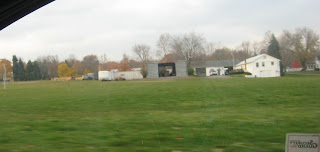The way that the farm looks in these pictures is the way that it looks most of the year. If you are just passing though town you may never get a chance to see the farm at it's prime time of year! To most people, experiencing this space it would seem plain and like nothing special. Every fall within these cornstalks pumpkins are growing waiting to be picked!
Thinking of this space in a new way, I thought of two different things. First I thought of a way you could set the mood for young children by reading them pumpkin poems similar to these both when the farm is set up for Halloween and when it isn't so that they know this is where the pumpkins are grown and picked:
Pumpkins
When you see me in the fields,
My orange glowing in the sun,
It's time to say goodbye to summer
and hello to autumn fun!!
Pumpkin Head
We bought a pumpkin big and round
that lived the summer through
without an eye to look at things...
and now it looks through two
It used to be all dark inside
when growing on the vine,
but now it has a toothy smile
and face that's full of shine.
-Aileen Fisher
Another way that I like to think about this space involves one of my favorite topics...FOOD. Pumpkins and fall to me means some of my favorite foods. Here are a few recipes for some of my favorite pumpkin related foods. Reading these recipes before heading to the Pumpkin patch would allow you to see the space in a different way. You would see it as a chef hunting for the perfect pumpkin to turn into something delicious rather then a Pumpkin Carver searching for the perfect 'canvas'.
Baked Stuffed Pumpkin
Ingredients:
2 pounds pumpkin, halved, seeded, top reserved2 apples, cored and quartered
½ cup walnuts, chopped
1 teaspoon ground cinnamon
½ teaspoon ground nutmeg
½ cup pineapple chunks, drained
¼ teaspoon ground cloves
Directions:
1. Preheat oven to 350°F.2. Place pumpkin cut side down on a baking pan and bake until soft, 40 to 45 minutes. Using a metal spoon, scrape out the cooked pumpkin, leaving a ¼-inch thick shell.
3. Process the apples in a food processor until chunky. Add remaining ingredients and pulse until just mixed but still chunky.
4. Spoon into reserved pumpkin shell. Cover with top of pumpkin shell and place on baking sheet. Bake until filling is hot and bubbly, 40 to 45 minutes. Cool slightly and serve.
Pumpkin Pie
Ingredients:
1 9-inch pie crust3/4 cup packed brown sugar
1 1/2 tablespoons sugar
3/4 teaspoon cinnamon
1/2 teaspoon ginger
1/2 teaspoon nutmeg
1/4 teaspoon allspice
¼ teaspoon salt
2 cups pureed cooked pumpkin
1 1/4 cups evaporated milk
3/4 cup egg whites, whipped
2 1/2 teaspoons vanilla
Directions:
1. Preheat oven to 375°F.2. In a large bowl, combine sugars, cinnamon, ginger, nutmeg, allspice, and salt.
3. In a separate large mixing bowl, combine pumpkin, milk, egg, and vanilla; whisk until smooth. Pour dry mixture into wet mixture and mix until just moistened.
4. Pour into prepared pie crust and bake 50 to 60 minutes, until crust is golden and filling is set in the center when jiggled. Cool and serve.
Pumpkin Soup
Ingredients:
1 tablespoon butter1 medium onion, finely chopped
2 cloves garlic, crushed
1 pound pumpkin, peeled, seeded, cut into 1-inch cubes
3 cups chicken stock
1 tablespoon tomato paste
1 tablespoon grated parmesan cheese
¼ teaspoon salt
¼ teaspoon pepper
Directions:
1. Melt butter in a large saucepan over medium heat. Add onions and garlic and cook until translucent, 3 to 4 minutes, stirring.2. Add pumpkin and cook 3 minutes, until lightly softened.
3. Add stock and paste and stir to mix. Bring to a boil over high heat, lower to a simmer, and cover. Cook 20 minutes, until pumpkin is very tender.
4. Transfer to a food processor and puree until smooth. Add cheese, salt, and pepper; mix and serve warm.
For more information on Conklin Farms, Click here.

















































